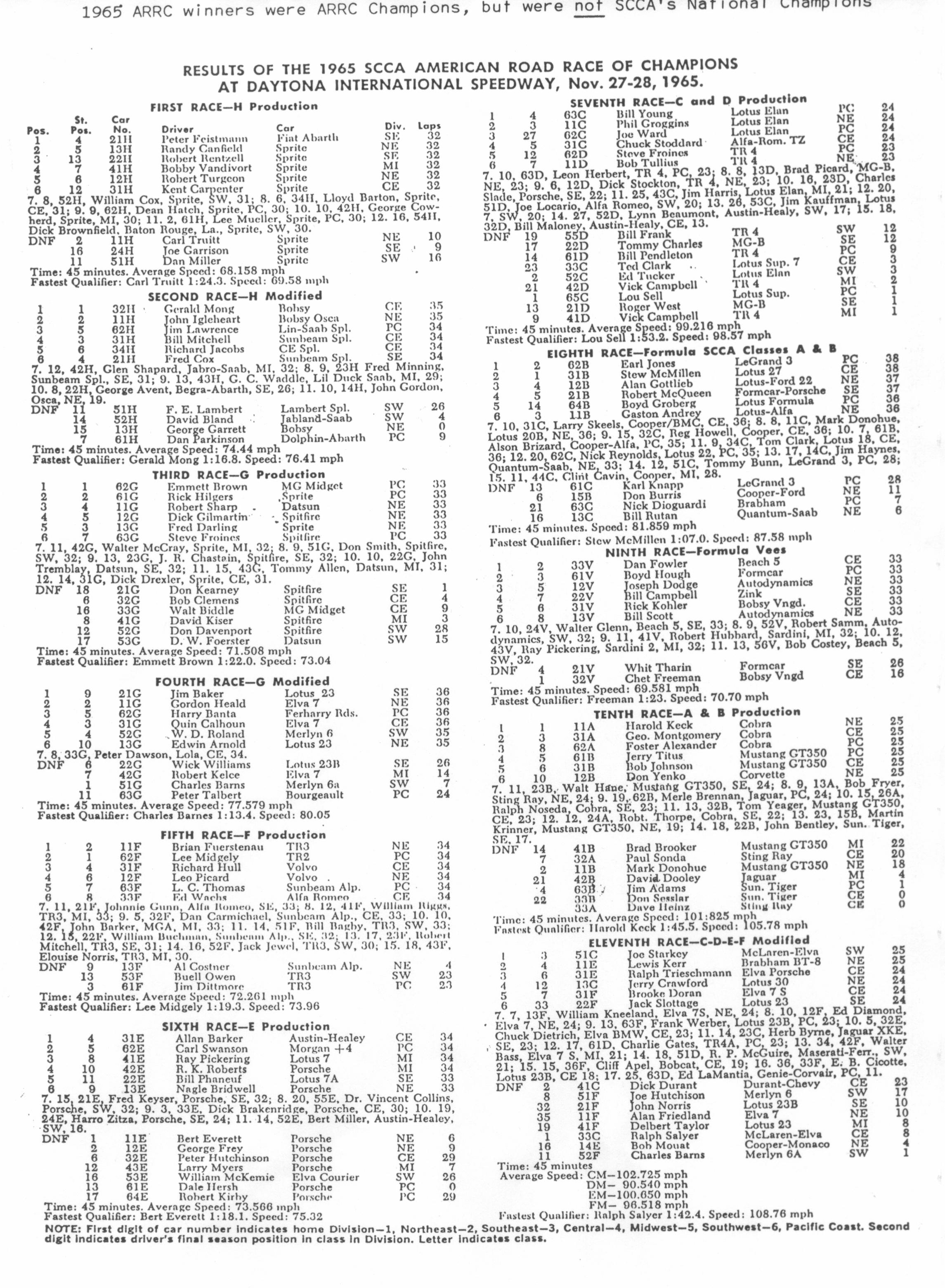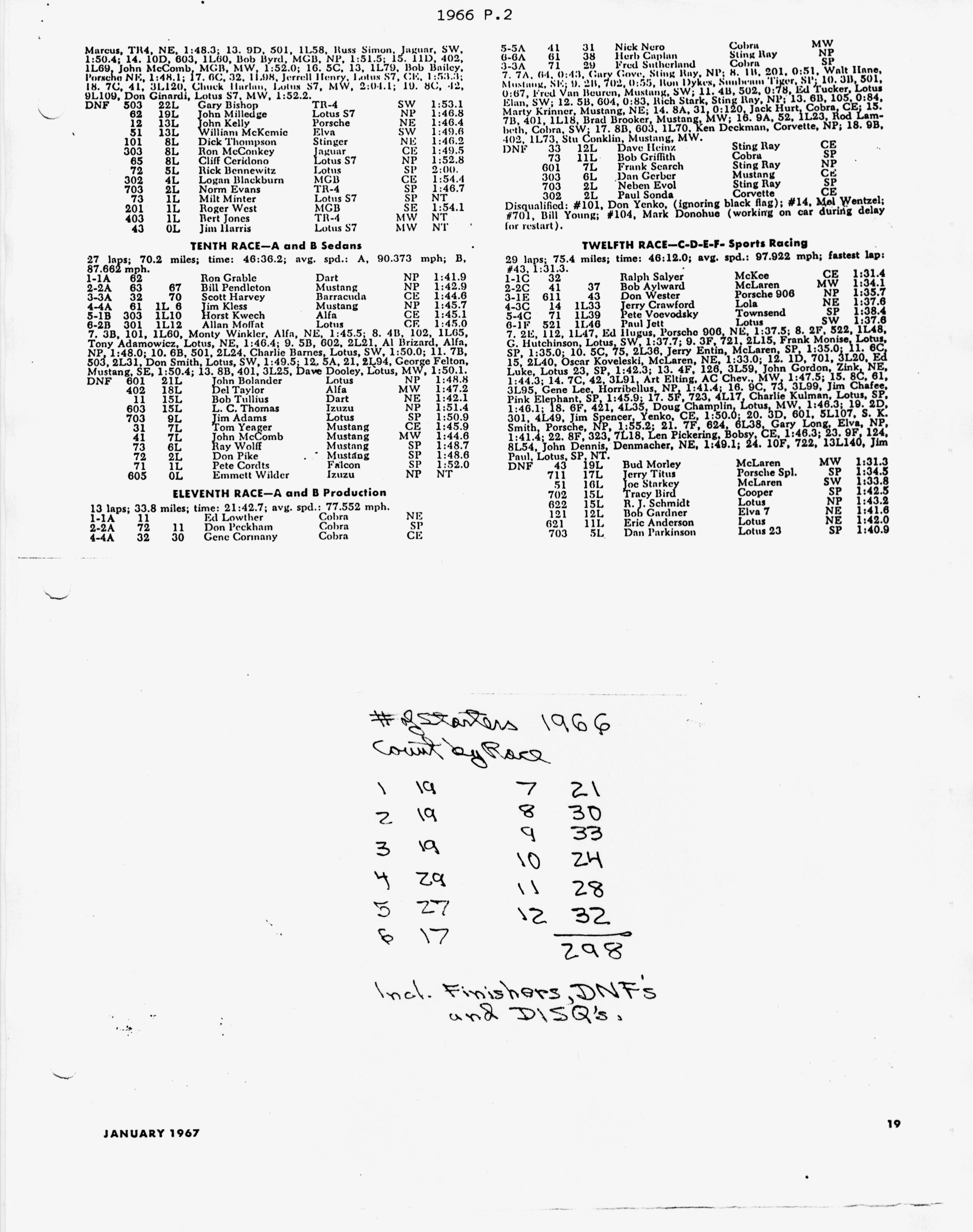Found on
http://www.thecarsource.com/ 

 The Shelby Group 2 Notchbacks
The Shelby Group 2 Notchbacks 1966, the Beginning of Trans-Am Racing
last updated April 17, 2005
During the mid-60's, pony cars were hot. The Ford Mustang was selling so well the other manufacturers came out with their own version of the short trunk cars. Owners and enthusiasts started taking their pony cars to the race track making sedan racing ever more popular. SCCA began to take notice and for 1966 established a sedan class with a National Championship category. The SCCA set up Group 2 cars under FIA Appendix 2. The amateur classes were based on displacement: A - 2000cc to 5000cc; B - 1300cc to 2000cc; D - under 1000cc. The Championship series included over 50 amateur races leading to an invitational American Road Race of Champions (ARRC) for the top three sedan class finishers in each of the seven geographical divisions.
A professional series was a established called The Trans-American Sedan Championship. This series of races was made up of seven professional races at different tracks across the US. The manufacturer with the most points at the end of the series would win the first ever Manufacturer's Trophy. The Trans-Am races, as it became known, ranged from 200 miles to 2,400 miles. The races ran from 2 hours to 24 hours and required pit stops for gas and tires.
Group 2 cars were divided into only two classes, over 2 litres and under 2 litres. The maximum displacement was 5 litres or 305 cid with a maximum wheelbase of 116 inches. Plus eligible cars had to seat 4 people eliminating the 65 GT 350s. In the beginning, the GT 350s were set up as two seaters to qualify for SCCA's Class B Production. The rear sears were removed and replaced with a fiberglass shelf. Ford wanted the Trans-Am Manufacturers Trophy. After the great success of the GT 350 fastbacks, Ford immediately turned the project over to Shelby American.
Shelby American built sixteen 1966 Group 2 Notchback Mustangs, all for sale to independents. Chuck Cantwell, GT 350 Project Engineer and Jerry Schwartz, fabricator & mechanic were given the job of developing and prepping the cars. The Mustangs were built to GT 350R specs. The main differences between the Group 2 cars and the GT 350Rs were cosmetic. The Group 2 Mustangs were required to be close to stock with steel hoods and front ends. The GT 350Rs had fiberglass hoods and front aprons, plastic side and rear windows. The Group 2 cars used glass windows. Stock interior and four seats were also required for the Group 2 cars.
The GT 350Rs and the Group 2 Mustangs had a lot of similarities. Both cars had:
* racing type, positive locking devices on the hoods and trunks
* 7"x15" American racing magnesium wheels
* lowered A-arms
* 34 gallon fuel tanks with 3 /12" quick release caps and splash funnels
* trunk mounted batteries
* Stewart Warner electric fuel pumps
* six CS gauges housed in a special instrument housing
fuel pressure, oil temp, 0-160 mph speedometer, 0-8,000 rpm tach, oil pressure, & water temp
* four point roll bar
* 3" competition lap belts with shoulder harness
* 18 quart Ford Galaxy radiator
* oil cooler with remote oil filter
* tube headers with 2 1/2" straight pipes dumping out just in front of the rear wheels
* "Monte Carlo" stabilizer bars to strengthen the front end
* export brace (named after the brace used on Mustangs for export)
* 11.3" front disc brakes
* 10"x2 1/2" wide rear drum brakes
* one inch sway bar
* 16" three spoke wood steering wheel
* stock Ford valve covers on the 289 cid with a special breather
* Koni shock absorbers
* Detroit "No-Spin" rear ratcheting differential
* 3.89 rear axle
* 19:1 quick steering
* Borg Warner T-10 close ratio four speeds
* 7.5 finned cast aluminum oil pan
* over ride traction bars
* Shelby American racing 289 cid with an aluminum hi-rise and a 715 cfm Holley carb
The engines developed over 350 horse power.
The Group 2 Mustangs were based on the Mustang GT. All Group 2 cars had the stock GT package including fog lights in the grilles. The lenses and bulbs were replaced with high intensity driving lights for better use during the night driving in some of the Trans-Am races. Most Group 2 racers came with a 1/2" rear sway bar and a Panhard rod. Some of the cars came with a scooped out fiberglass panel between the passenger compartment and the trunk allowing a spare tire to be mounted. The spare would not fit in the trunk with the larger gas tank. A spare tire was not required during racing. It is possible this option was shared with the four Group 1 race cars Shelby America sent to Europe. This a rare item to see today in restored cars. The SCCA required a metal bulkhead between the driver's compartment and the gas tank early in 1967. Any car raced during 1967 had to have the bulkhead replacing the fiberglass spare tire mount.
The 16 Group 2 Mustangs were painted white with black interiors. All cars were sold to independent teams. Shelby did not run a Group 2 Trans-Am team in 1966. Only one car was completed in time for the Trans-Am race at Sebring in 1966. Three were to be available. The first car went to Cooper, Clark & Associates. They paid $6,414 for the first Group 2 car in a bidding war. Later Group 2 Mustang sold for $5,500.
Shelby prepared cars placed in five out the remaining six races. Independent teams drove non-Shelby Group 2 Mustangs to wins at Mid-America Raceway, the Virginia 400 and second at Briar 250. Ford and Chrysler fought for the lead in points up to the last two races. At Green Valley, Brad Booker and John McComb driving a Shelby Group 2 Mustang beat out the "Team Starfish" Barracudas and Group 44 Dodge Darts to win tying the standings at 37 each for Chrysler and Ford.
The last race of the season was at the Riverside Track in California. Shelby sent Jerry Titus to drive a Shelby Group 2 Mustang. During the qualifying on Saturday Titus set a track lap record of 1:41.9 at an average of 91.854 miles per hour to earn the number one spot for the race on Sunday. The race started with a LeMans type start. Titus flooded his Mustang leaving him next to last to start. A later broken oil filter cost him almost two laps while it was being replaced. Titus fought his way through the 34 cars to finish first, 48 seconds ahead of the Tullis Group 44 Dodge Dart. Mustang and Ford won the first Trans-Am Manufacturers Trophy.
Source of information: SAAC Shelby American, issue #50 from an article written by Bill Hanlon







